Are They Enough?
VerifiedAdded on 2019/12/03
|9
|2378
|360
Report
AI Summary
The provided content discusses delirium, a common condition in elderly adults, which is characterized by altered mental status and difficulty focusing. The articles and online resources cover various aspects of delirium, including its diagnosis, prevention, and treatment. They also explore the connection between dementia and delirium, as well as possible underlying conditions that may cause delirium. The summary aims to provide a comprehensive overview of the provided content, highlighting key points and insights.
Contribute Materials
Your contribution can guide someone’s learning journey. Share your
documents today.
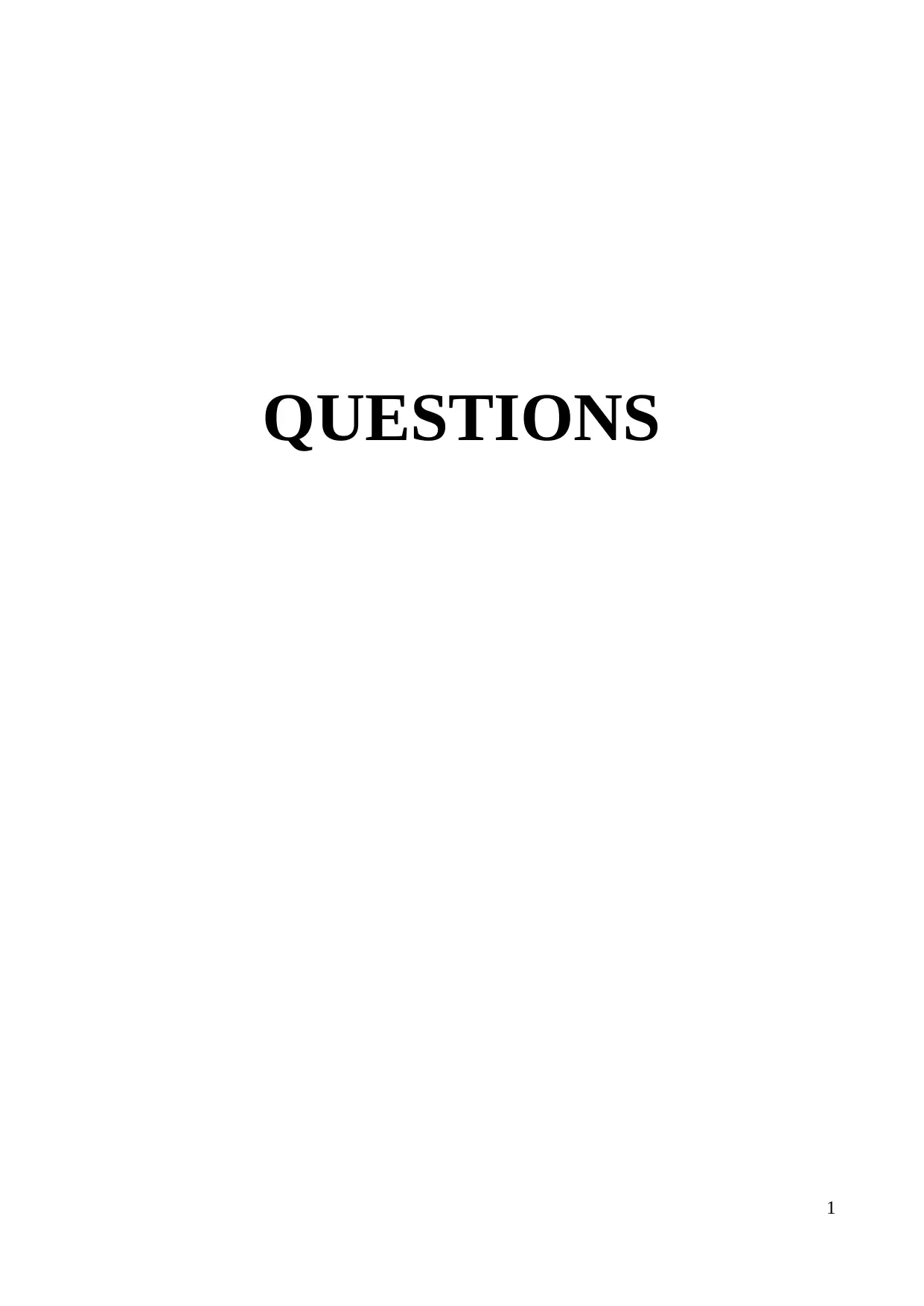
QUESTIONS
1
1
Secure Best Marks with AI Grader
Need help grading? Try our AI Grader for instant feedback on your assignments.
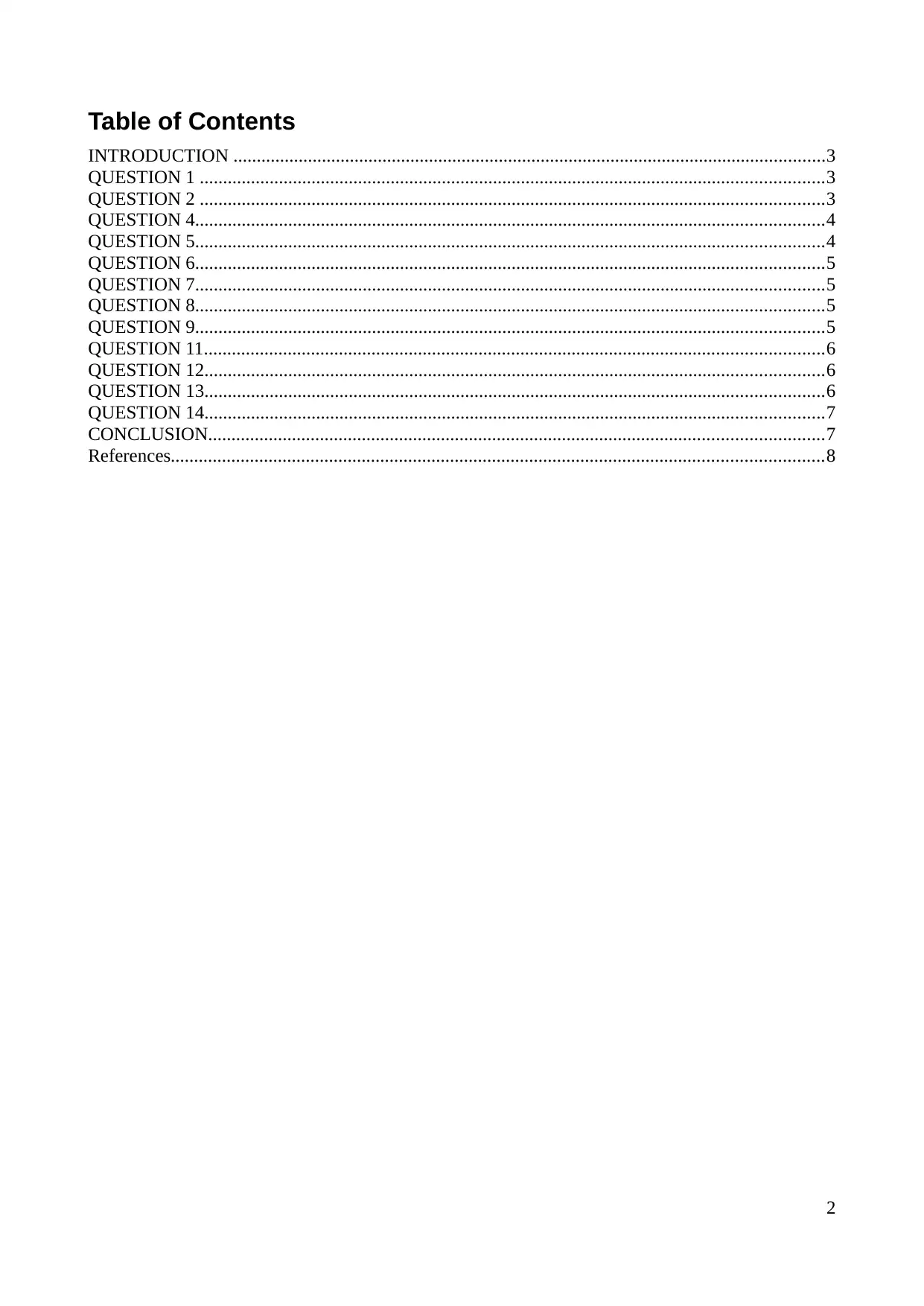
Table of Contents
INTRODUCTION ...............................................................................................................................3
QUESTION 1 ......................................................................................................................................3
QUESTION 2 ......................................................................................................................................3
QUESTION 4.......................................................................................................................................4
QUESTION 5.......................................................................................................................................4
QUESTION 6.......................................................................................................................................5
QUESTION 7.......................................................................................................................................5
QUESTION 8.......................................................................................................................................5
QUESTION 9.......................................................................................................................................5
QUESTION 11.....................................................................................................................................6
QUESTION 12.....................................................................................................................................6
QUESTION 13.....................................................................................................................................6
QUESTION 14.....................................................................................................................................7
CONCLUSION....................................................................................................................................7
References............................................................................................................................................8
2
INTRODUCTION ...............................................................................................................................3
QUESTION 1 ......................................................................................................................................3
QUESTION 2 ......................................................................................................................................3
QUESTION 4.......................................................................................................................................4
QUESTION 5.......................................................................................................................................4
QUESTION 6.......................................................................................................................................5
QUESTION 7.......................................................................................................................................5
QUESTION 8.......................................................................................................................................5
QUESTION 9.......................................................................................................................................5
QUESTION 11.....................................................................................................................................6
QUESTION 12.....................................................................................................................................6
QUESTION 13.....................................................................................................................................6
QUESTION 14.....................................................................................................................................7
CONCLUSION....................................................................................................................................7
References............................................................................................................................................8
2
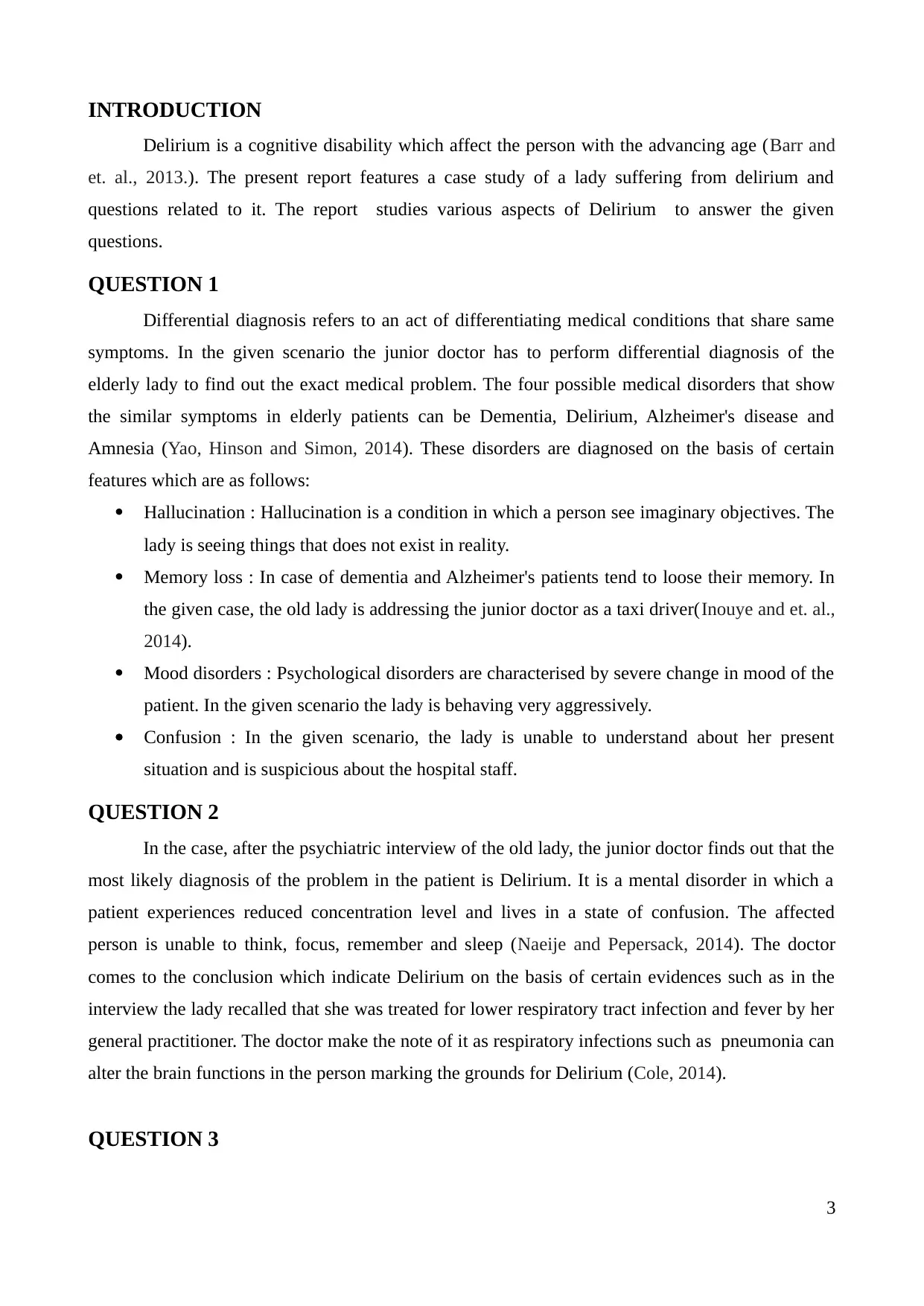
INTRODUCTION
Delirium is a cognitive disability which affect the person with the advancing age (Barr and
et. al., 2013.). The present report features a case study of a lady suffering from delirium and
questions related to it. The report studies various aspects of Delirium to answer the given
questions.
QUESTION 1
Differential diagnosis refers to an act of differentiating medical conditions that share same
symptoms. In the given scenario the junior doctor has to perform differential diagnosis of the
elderly lady to find out the exact medical problem. The four possible medical disorders that show
the similar symptoms in elderly patients can be Dementia, Delirium, Alzheimer's disease and
Amnesia (Yao, Hinson and Simon, 2014). These disorders are diagnosed on the basis of certain
features which are as follows:
Hallucination : Hallucination is a condition in which a person see imaginary objectives. The
lady is seeing things that does not exist in reality.
Memory loss : In case of dementia and Alzheimer's patients tend to loose their memory. In
the given case, the old lady is addressing the junior doctor as a taxi driver(Inouye and et. al.,
2014).
Mood disorders : Psychological disorders are characterised by severe change in mood of the
patient. In the given scenario the lady is behaving very aggressively.
Confusion : In the given scenario, the lady is unable to understand about her present
situation and is suspicious about the hospital staff.
QUESTION 2
In the case, after the psychiatric interview of the old lady, the junior doctor finds out that the
most likely diagnosis of the problem in the patient is Delirium. It is a mental disorder in which a
patient experiences reduced concentration level and lives in a state of confusion. The affected
person is unable to think, focus, remember and sleep (Naeije and Pepersack, 2014). The doctor
comes to the conclusion which indicate Delirium on the basis of certain evidences such as in the
interview the lady recalled that she was treated for lower respiratory tract infection and fever by her
general practitioner. The doctor make the note of it as respiratory infections such as pneumonia can
alter the brain functions in the person marking the grounds for Delirium (Cole, 2014).
QUESTION 3
3
Delirium is a cognitive disability which affect the person with the advancing age (Barr and
et. al., 2013.). The present report features a case study of a lady suffering from delirium and
questions related to it. The report studies various aspects of Delirium to answer the given
questions.
QUESTION 1
Differential diagnosis refers to an act of differentiating medical conditions that share same
symptoms. In the given scenario the junior doctor has to perform differential diagnosis of the
elderly lady to find out the exact medical problem. The four possible medical disorders that show
the similar symptoms in elderly patients can be Dementia, Delirium, Alzheimer's disease and
Amnesia (Yao, Hinson and Simon, 2014). These disorders are diagnosed on the basis of certain
features which are as follows:
Hallucination : Hallucination is a condition in which a person see imaginary objectives. The
lady is seeing things that does not exist in reality.
Memory loss : In case of dementia and Alzheimer's patients tend to loose their memory. In
the given case, the old lady is addressing the junior doctor as a taxi driver(Inouye and et. al.,
2014).
Mood disorders : Psychological disorders are characterised by severe change in mood of the
patient. In the given scenario the lady is behaving very aggressively.
Confusion : In the given scenario, the lady is unable to understand about her present
situation and is suspicious about the hospital staff.
QUESTION 2
In the case, after the psychiatric interview of the old lady, the junior doctor finds out that the
most likely diagnosis of the problem in the patient is Delirium. It is a mental disorder in which a
patient experiences reduced concentration level and lives in a state of confusion. The affected
person is unable to think, focus, remember and sleep (Naeije and Pepersack, 2014). The doctor
comes to the conclusion which indicate Delirium on the basis of certain evidences such as in the
interview the lady recalled that she was treated for lower respiratory tract infection and fever by her
general practitioner. The doctor make the note of it as respiratory infections such as pneumonia can
alter the brain functions in the person marking the grounds for Delirium (Cole, 2014).
QUESTION 3
3
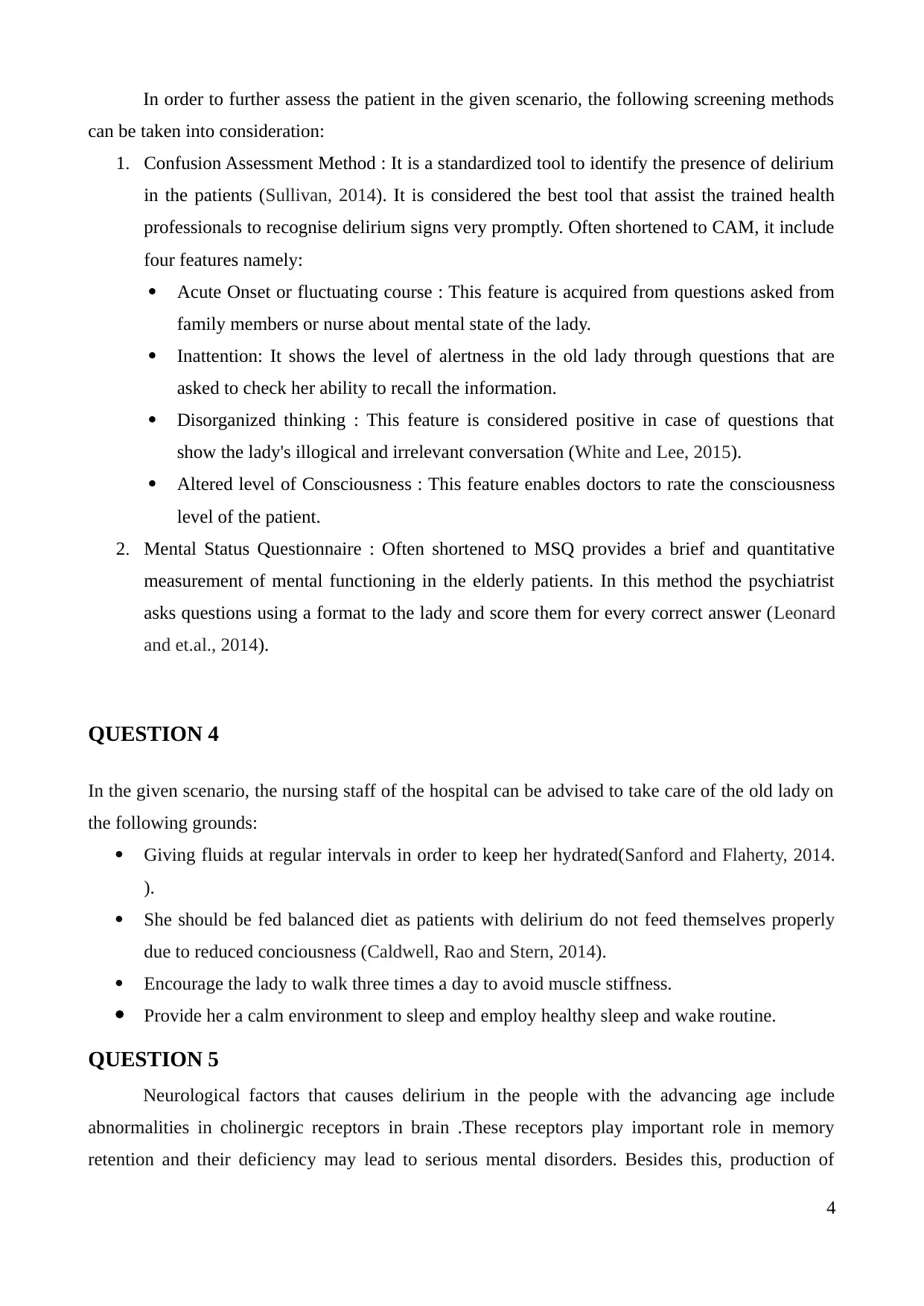
In order to further assess the patient in the given scenario, the following screening methods
can be taken into consideration:
1. Confusion Assessment Method : It is a standardized tool to identify the presence of delirium
in the patients (Sullivan, 2014). It is considered the best tool that assist the trained health
professionals to recognise delirium signs very promptly. Often shortened to CAM, it include
four features namely:
Acute Onset or fluctuating course : This feature is acquired from questions asked from
family members or nurse about mental state of the lady.
Inattention: It shows the level of alertness in the old lady through questions that are
asked to check her ability to recall the information.
Disorganized thinking : This feature is considered positive in case of questions that
show the lady's illogical and irrelevant conversation (White and Lee, 2015).
Altered level of Consciousness : This feature enables doctors to rate the consciousness
level of the patient.
2. Mental Status Questionnaire : Often shortened to MSQ provides a brief and quantitative
measurement of mental functioning in the elderly patients. In this method the psychiatrist
asks questions using a format to the lady and score them for every correct answer (Leonard
and et.al., 2014).
QUESTION 4
In the given scenario, the nursing staff of the hospital can be advised to take care of the old lady on
the following grounds:
Giving fluids at regular intervals in order to keep her hydrated(Sanford and Flaherty, 2014.
).
She should be fed balanced diet as patients with delirium do not feed themselves properly
due to reduced conciousness (Caldwell, Rao and Stern, 2014).
Encourage the lady to walk three times a day to avoid muscle stiffness.
Provide her a calm environment to sleep and employ healthy sleep and wake routine.
QUESTION 5
Neurological factors that causes delirium in the people with the advancing age include
abnormalities in cholinergic receptors in brain .These receptors play important role in memory
retention and their deficiency may lead to serious mental disorders. Besides this, production of
4
can be taken into consideration:
1. Confusion Assessment Method : It is a standardized tool to identify the presence of delirium
in the patients (Sullivan, 2014). It is considered the best tool that assist the trained health
professionals to recognise delirium signs very promptly. Often shortened to CAM, it include
four features namely:
Acute Onset or fluctuating course : This feature is acquired from questions asked from
family members or nurse about mental state of the lady.
Inattention: It shows the level of alertness in the old lady through questions that are
asked to check her ability to recall the information.
Disorganized thinking : This feature is considered positive in case of questions that
show the lady's illogical and irrelevant conversation (White and Lee, 2015).
Altered level of Consciousness : This feature enables doctors to rate the consciousness
level of the patient.
2. Mental Status Questionnaire : Often shortened to MSQ provides a brief and quantitative
measurement of mental functioning in the elderly patients. In this method the psychiatrist
asks questions using a format to the lady and score them for every correct answer (Leonard
and et.al., 2014).
QUESTION 4
In the given scenario, the nursing staff of the hospital can be advised to take care of the old lady on
the following grounds:
Giving fluids at regular intervals in order to keep her hydrated(Sanford and Flaherty, 2014.
).
She should be fed balanced diet as patients with delirium do not feed themselves properly
due to reduced conciousness (Caldwell, Rao and Stern, 2014).
Encourage the lady to walk three times a day to avoid muscle stiffness.
Provide her a calm environment to sleep and employ healthy sleep and wake routine.
QUESTION 5
Neurological factors that causes delirium in the people with the advancing age include
abnormalities in cholinergic receptors in brain .These receptors play important role in memory
retention and their deficiency may lead to serious mental disorders. Besides this, production of
4
Secure Best Marks with AI Grader
Need help grading? Try our AI Grader for instant feedback on your assignments.
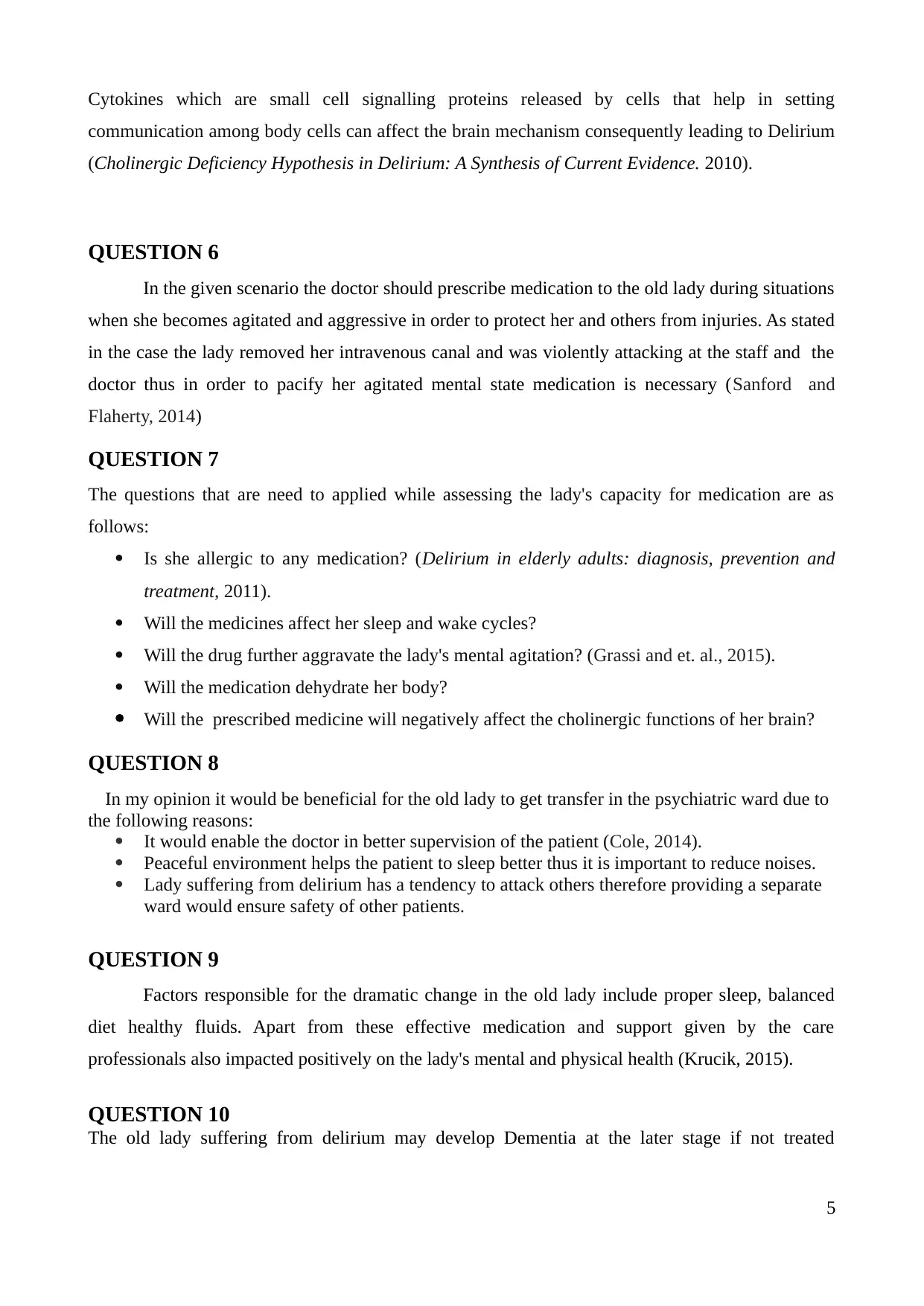
Cytokines which are small cell signalling proteins released by cells that help in setting
communication among body cells can affect the brain mechanism consequently leading to Delirium
(Cholinergic Deficiency Hypothesis in Delirium: A Synthesis of Current Evidence. 2010).
QUESTION 6
In the given scenario the doctor should prescribe medication to the old lady during situations
when she becomes agitated and aggressive in order to protect her and others from injuries. As stated
in the case the lady removed her intravenous canal and was violently attacking at the staff and the
doctor thus in order to pacify her agitated mental state medication is necessary (Sanford and
Flaherty, 2014)
QUESTION 7
The questions that are need to applied while assessing the lady's capacity for medication are as
follows:
Is she allergic to any medication? (Delirium in elderly adults: diagnosis, prevention and
treatment, 2011).
Will the medicines affect her sleep and wake cycles?
Will the drug further aggravate the lady's mental agitation? (Grassi and et. al., 2015).
Will the medication dehydrate her body?
Will the prescribed medicine will negatively affect the cholinergic functions of her brain?
QUESTION 8
In my opinion it would be beneficial for the old lady to get transfer in the psychiatric ward due to
the following reasons:
It would enable the doctor in better supervision of the patient (Cole, 2014).
Peaceful environment helps the patient to sleep better thus it is important to reduce noises.
Lady suffering from delirium has a tendency to attack others therefore providing a separate
ward would ensure safety of other patients.
QUESTION 9
Factors responsible for the dramatic change in the old lady include proper sleep, balanced
diet healthy fluids. Apart from these effective medication and support given by the care
professionals also impacted positively on the lady's mental and physical health (Krucik, 2015).
QUESTION 10
The old lady suffering from delirium may develop Dementia at the later stage if not treated
5
communication among body cells can affect the brain mechanism consequently leading to Delirium
(Cholinergic Deficiency Hypothesis in Delirium: A Synthesis of Current Evidence. 2010).
QUESTION 6
In the given scenario the doctor should prescribe medication to the old lady during situations
when she becomes agitated and aggressive in order to protect her and others from injuries. As stated
in the case the lady removed her intravenous canal and was violently attacking at the staff and the
doctor thus in order to pacify her agitated mental state medication is necessary (Sanford and
Flaherty, 2014)
QUESTION 7
The questions that are need to applied while assessing the lady's capacity for medication are as
follows:
Is she allergic to any medication? (Delirium in elderly adults: diagnosis, prevention and
treatment, 2011).
Will the medicines affect her sleep and wake cycles?
Will the drug further aggravate the lady's mental agitation? (Grassi and et. al., 2015).
Will the medication dehydrate her body?
Will the prescribed medicine will negatively affect the cholinergic functions of her brain?
QUESTION 8
In my opinion it would be beneficial for the old lady to get transfer in the psychiatric ward due to
the following reasons:
It would enable the doctor in better supervision of the patient (Cole, 2014).
Peaceful environment helps the patient to sleep better thus it is important to reduce noises.
Lady suffering from delirium has a tendency to attack others therefore providing a separate
ward would ensure safety of other patients.
QUESTION 9
Factors responsible for the dramatic change in the old lady include proper sleep, balanced
diet healthy fluids. Apart from these effective medication and support given by the care
professionals also impacted positively on the lady's mental and physical health (Krucik, 2015).
QUESTION 10
The old lady suffering from delirium may develop Dementia at the later stage if not treated
5
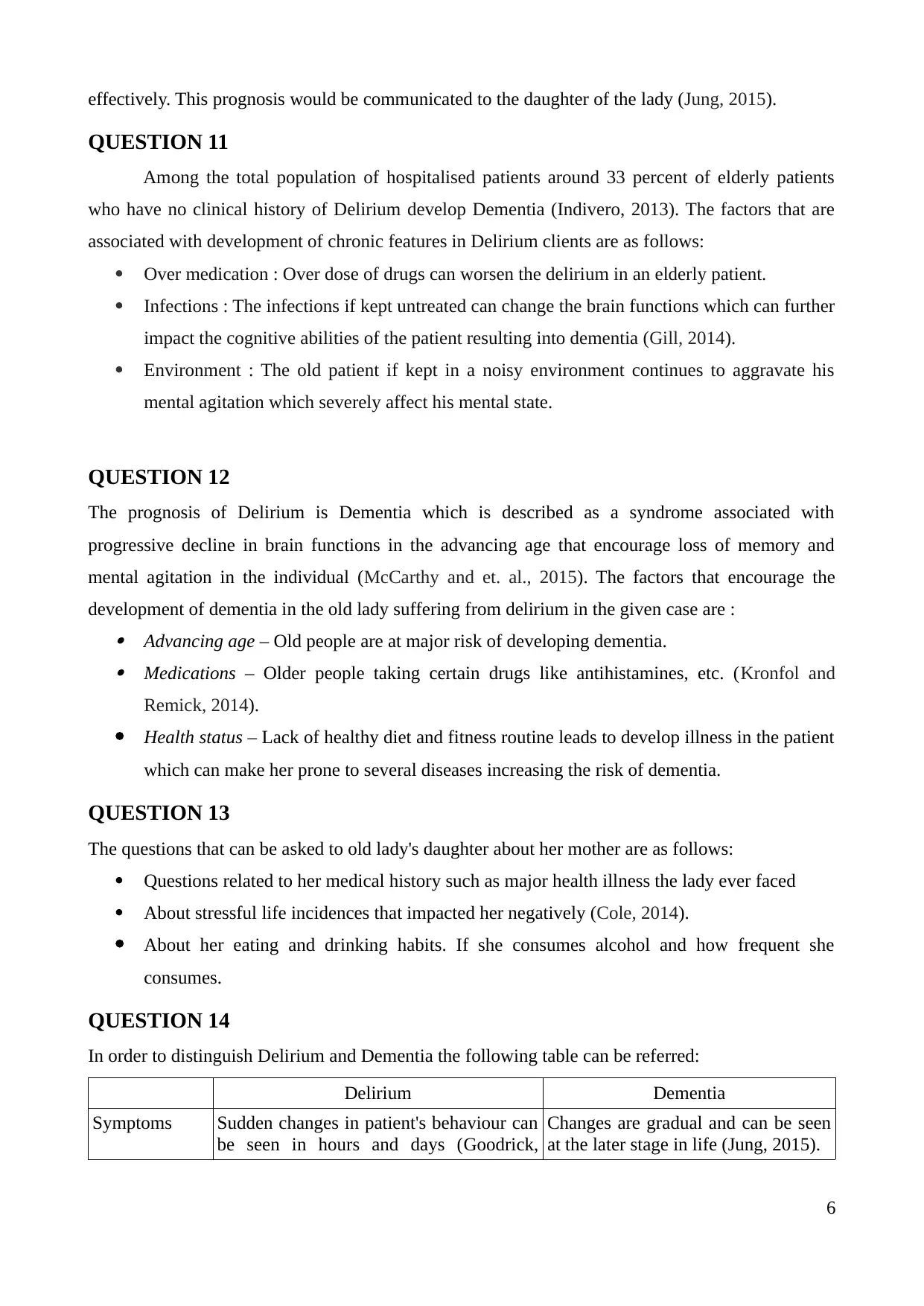
effectively. This prognosis would be communicated to the daughter of the lady (Jung, 2015).
QUESTION 11
Among the total population of hospitalised patients around 33 percent of elderly patients
who have no clinical history of Delirium develop Dementia (Indivero, 2013). The factors that are
associated with development of chronic features in Delirium clients are as follows:
Over medication : Over dose of drugs can worsen the delirium in an elderly patient.
Infections : The infections if kept untreated can change the brain functions which can further
impact the cognitive abilities of the patient resulting into dementia (Gill, 2014).
Environment : The old patient if kept in a noisy environment continues to aggravate his
mental agitation which severely affect his mental state.
QUESTION 12
The prognosis of Delirium is Dementia which is described as a syndrome associated with
progressive decline in brain functions in the advancing age that encourage loss of memory and
mental agitation in the individual (McCarthy and et. al., 2015). The factors that encourage the
development of dementia in the old lady suffering from delirium in the given case are : Advancing age – Old people are at major risk of developing dementia. Medications – Older people taking certain drugs like antihistamines, etc. (Kronfol and
Remick, 2014).
Health status – Lack of healthy diet and fitness routine leads to develop illness in the patient
which can make her prone to several diseases increasing the risk of dementia.
QUESTION 13
The questions that can be asked to old lady's daughter about her mother are as follows:
Questions related to her medical history such as major health illness the lady ever faced
About stressful life incidences that impacted her negatively (Cole, 2014).
About her eating and drinking habits. If she consumes alcohol and how frequent she
consumes.
QUESTION 14
In order to distinguish Delirium and Dementia the following table can be referred:
Delirium Dementia
Symptoms Sudden changes in patient's behaviour can
be seen in hours and days (Goodrick,
Changes are gradual and can be seen
at the later stage in life (Jung, 2015).
6
QUESTION 11
Among the total population of hospitalised patients around 33 percent of elderly patients
who have no clinical history of Delirium develop Dementia (Indivero, 2013). The factors that are
associated with development of chronic features in Delirium clients are as follows:
Over medication : Over dose of drugs can worsen the delirium in an elderly patient.
Infections : The infections if kept untreated can change the brain functions which can further
impact the cognitive abilities of the patient resulting into dementia (Gill, 2014).
Environment : The old patient if kept in a noisy environment continues to aggravate his
mental agitation which severely affect his mental state.
QUESTION 12
The prognosis of Delirium is Dementia which is described as a syndrome associated with
progressive decline in brain functions in the advancing age that encourage loss of memory and
mental agitation in the individual (McCarthy and et. al., 2015). The factors that encourage the
development of dementia in the old lady suffering from delirium in the given case are : Advancing age – Old people are at major risk of developing dementia. Medications – Older people taking certain drugs like antihistamines, etc. (Kronfol and
Remick, 2014).
Health status – Lack of healthy diet and fitness routine leads to develop illness in the patient
which can make her prone to several diseases increasing the risk of dementia.
QUESTION 13
The questions that can be asked to old lady's daughter about her mother are as follows:
Questions related to her medical history such as major health illness the lady ever faced
About stressful life incidences that impacted her negatively (Cole, 2014).
About her eating and drinking habits. If she consumes alcohol and how frequent she
consumes.
QUESTION 14
In order to distinguish Delirium and Dementia the following table can be referred:
Delirium Dementia
Symptoms Sudden changes in patient's behaviour can
be seen in hours and days (Goodrick,
Changes are gradual and can be seen
at the later stage in life (Jung, 2015).
6
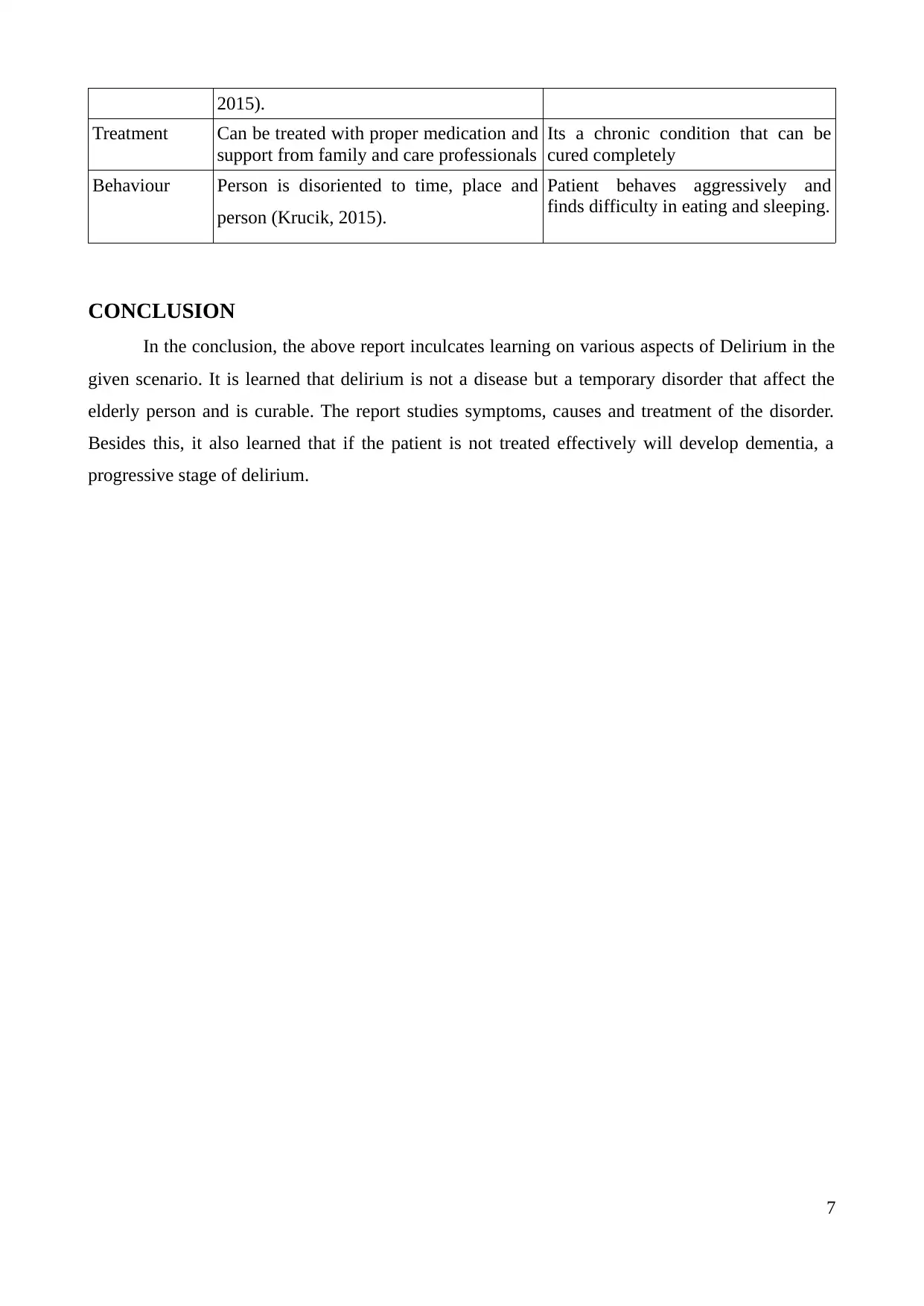
2015).
Treatment Can be treated with proper medication and
support from family and care professionals
Its a chronic condition that can be
cured completely
Behaviour Person is disoriented to time, place and
person (Krucik, 2015).
Patient behaves aggressively and
finds difficulty in eating and sleeping.
CONCLUSION
In the conclusion, the above report inculcates learning on various aspects of Delirium in the
given scenario. It is learned that delirium is not a disease but a temporary disorder that affect the
elderly person and is curable. The report studies symptoms, causes and treatment of the disorder.
Besides this, it also learned that if the patient is not treated effectively will develop dementia, a
progressive stage of delirium.
7
Treatment Can be treated with proper medication and
support from family and care professionals
Its a chronic condition that can be
cured completely
Behaviour Person is disoriented to time, place and
person (Krucik, 2015).
Patient behaves aggressively and
finds difficulty in eating and sleeping.
CONCLUSION
In the conclusion, the above report inculcates learning on various aspects of Delirium in the
given scenario. It is learned that delirium is not a disease but a temporary disorder that affect the
elderly person and is curable. The report studies symptoms, causes and treatment of the disorder.
Besides this, it also learned that if the patient is not treated effectively will develop dementia, a
progressive stage of delirium.
7
Paraphrase This Document
Need a fresh take? Get an instant paraphrase of this document with our AI Paraphraser
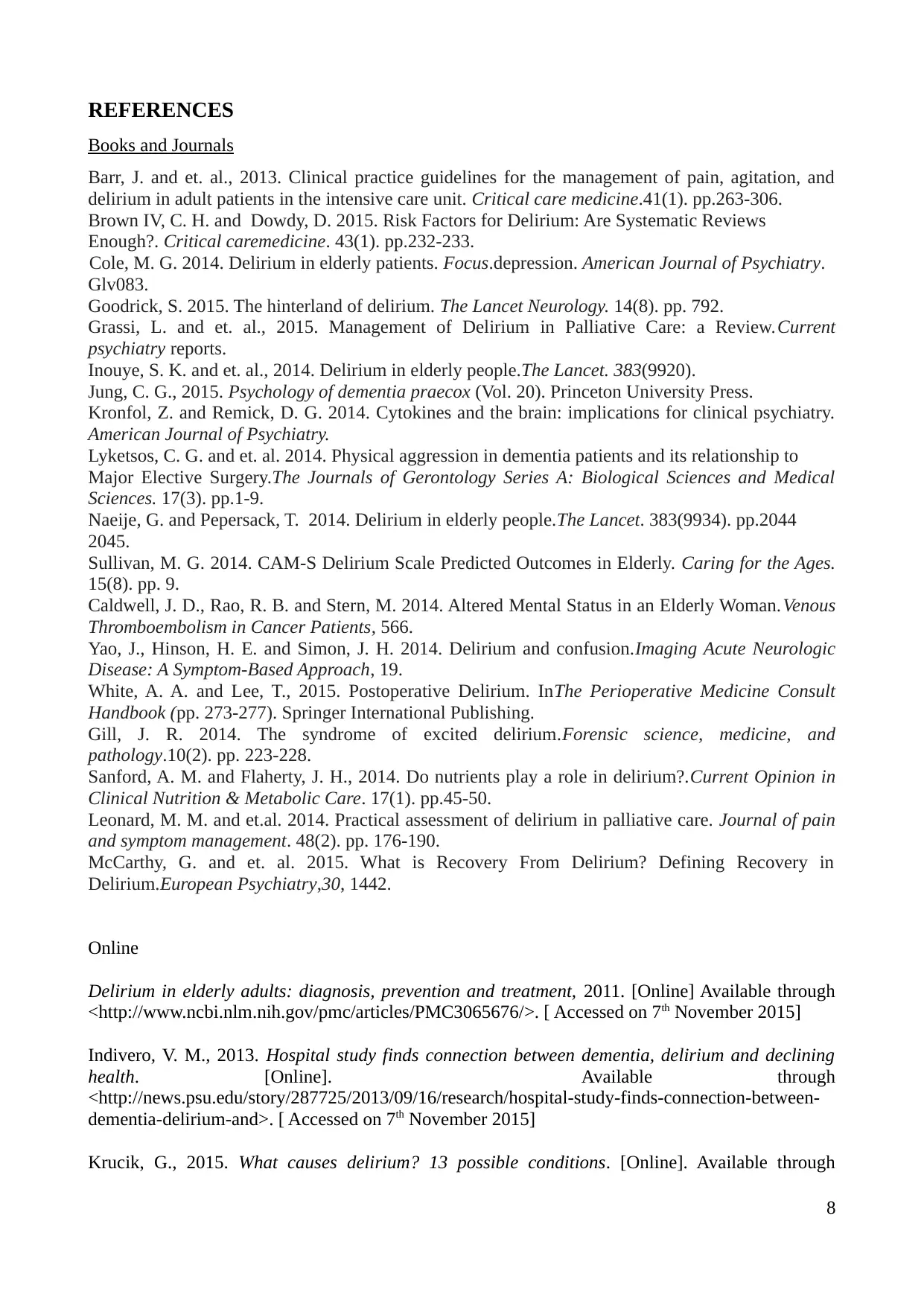
REFERENCES
Books and Journals
Barr, J. and et. al., 2013. Clinical practice guidelines for the management of pain, agitation, and
delirium in adult patients in the intensive care unit. Critical care medicine.41(1). pp.263-306.
Brown IV, C. H. and Dowdy, D. 2015. Risk Factors for Delirium: Are Systematic Reviews
Enough?. Critical caremedicine. 43(1). pp.232-233.
Cole, M. G. 2014. Delirium in elderly patients. Focus.depression. American Journal of Psychiatry.
Glv083.
Goodrick, S. 2015. The hinterland of delirium. The Lancet Neurology. 14(8). pp. 792.
Grassi, L. and et. al., 2015. Management of Delirium in Palliative Care: a Review.Current
psychiatry reports.
Inouye, S. K. and et. al., 2014. Delirium in elderly people.The Lancet. 383(9920).
Jung, C. G., 2015. Psychology of dementia praecox (Vol. 20). Princeton University Press.
Kronfol, Z. and Remick, D. G. 2014. Cytokines and the brain: implications for clinical psychiatry.
American Journal of Psychiatry.
Lyketsos, C. G. and et. al. 2014. Physical aggression in dementia patients and its relationship to
Major Elective Surgery.The Journals of Gerontology Series A: Biological Sciences and Medical
Sciences. 17(3). pp.1-9.
Naeije, G. and Pepersack, T. 2014. Delirium in elderly people.The Lancet. 383(9934). pp.2044
2045.
Sullivan, M. G. 2014. CAM-S Delirium Scale Predicted Outcomes in Elderly. Caring for the Ages.
15(8). pp. 9.
Caldwell, J. D., Rao, R. B. and Stern, M. 2014. Altered Mental Status in an Elderly Woman.Venous
Thromboembolism in Cancer Patients, 566.
Yao, J., Hinson, H. E. and Simon, J. H. 2014. Delirium and confusion.Imaging Acute Neurologic
Disease: A Symptom-Based Approach, 19.
White, A. A. and Lee, T., 2015. Postoperative Delirium. InThe Perioperative Medicine Consult
Handbook (pp. 273-277). Springer International Publishing.
Gill, J. R. 2014. The syndrome of excited delirium.Forensic science, medicine, and
pathology.10(2). pp. 223-228.
Sanford, A. M. and Flaherty, J. H., 2014. Do nutrients play a role in delirium?.Current Opinion in
Clinical Nutrition & Metabolic Care. 17(1). pp.45-50.
Leonard, M. M. and et.al. 2014. Practical assessment of delirium in palliative care. Journal of pain
and symptom management. 48(2). pp. 176-190.
McCarthy, G. and et. al. 2015. What is Recovery From Delirium? Defining Recovery in
Delirium.European Psychiatry,30, 1442.
Online
Delirium in elderly adults: diagnosis, prevention and treatment, 2011. [Online] Available through
<http://www.ncbi.nlm.nih.gov/pmc/articles/PMC3065676/>. [ Accessed on 7th November 2015]
Indivero, V. M., 2013. Hospital study finds connection between dementia, delirium and declining
health. [Online]. Available through
<http://news.psu.edu/story/287725/2013/09/16/research/hospital-study-finds-connection-between-
dementia-delirium-and>. [ Accessed on 7th November 2015]
Krucik, G., 2015. What causes delirium? 13 possible conditions. [Online]. Available through
8
Books and Journals
Barr, J. and et. al., 2013. Clinical practice guidelines for the management of pain, agitation, and
delirium in adult patients in the intensive care unit. Critical care medicine.41(1). pp.263-306.
Brown IV, C. H. and Dowdy, D. 2015. Risk Factors for Delirium: Are Systematic Reviews
Enough?. Critical caremedicine. 43(1). pp.232-233.
Cole, M. G. 2014. Delirium in elderly patients. Focus.depression. American Journal of Psychiatry.
Glv083.
Goodrick, S. 2015. The hinterland of delirium. The Lancet Neurology. 14(8). pp. 792.
Grassi, L. and et. al., 2015. Management of Delirium in Palliative Care: a Review.Current
psychiatry reports.
Inouye, S. K. and et. al., 2014. Delirium in elderly people.The Lancet. 383(9920).
Jung, C. G., 2015. Psychology of dementia praecox (Vol. 20). Princeton University Press.
Kronfol, Z. and Remick, D. G. 2014. Cytokines and the brain: implications for clinical psychiatry.
American Journal of Psychiatry.
Lyketsos, C. G. and et. al. 2014. Physical aggression in dementia patients and its relationship to
Major Elective Surgery.The Journals of Gerontology Series A: Biological Sciences and Medical
Sciences. 17(3). pp.1-9.
Naeije, G. and Pepersack, T. 2014. Delirium in elderly people.The Lancet. 383(9934). pp.2044
2045.
Sullivan, M. G. 2014. CAM-S Delirium Scale Predicted Outcomes in Elderly. Caring for the Ages.
15(8). pp. 9.
Caldwell, J. D., Rao, R. B. and Stern, M. 2014. Altered Mental Status in an Elderly Woman.Venous
Thromboembolism in Cancer Patients, 566.
Yao, J., Hinson, H. E. and Simon, J. H. 2014. Delirium and confusion.Imaging Acute Neurologic
Disease: A Symptom-Based Approach, 19.
White, A. A. and Lee, T., 2015. Postoperative Delirium. InThe Perioperative Medicine Consult
Handbook (pp. 273-277). Springer International Publishing.
Gill, J. R. 2014. The syndrome of excited delirium.Forensic science, medicine, and
pathology.10(2). pp. 223-228.
Sanford, A. M. and Flaherty, J. H., 2014. Do nutrients play a role in delirium?.Current Opinion in
Clinical Nutrition & Metabolic Care. 17(1). pp.45-50.
Leonard, M. M. and et.al. 2014. Practical assessment of delirium in palliative care. Journal of pain
and symptom management. 48(2). pp. 176-190.
McCarthy, G. and et. al. 2015. What is Recovery From Delirium? Defining Recovery in
Delirium.European Psychiatry,30, 1442.
Online
Delirium in elderly adults: diagnosis, prevention and treatment, 2011. [Online] Available through
<http://www.ncbi.nlm.nih.gov/pmc/articles/PMC3065676/>. [ Accessed on 7th November 2015]
Indivero, V. M., 2013. Hospital study finds connection between dementia, delirium and declining
health. [Online]. Available through
<http://news.psu.edu/story/287725/2013/09/16/research/hospital-study-finds-connection-between-
dementia-delirium-and>. [ Accessed on 7th November 2015]
Krucik, G., 2015. What causes delirium? 13 possible conditions. [Online]. Available through
8
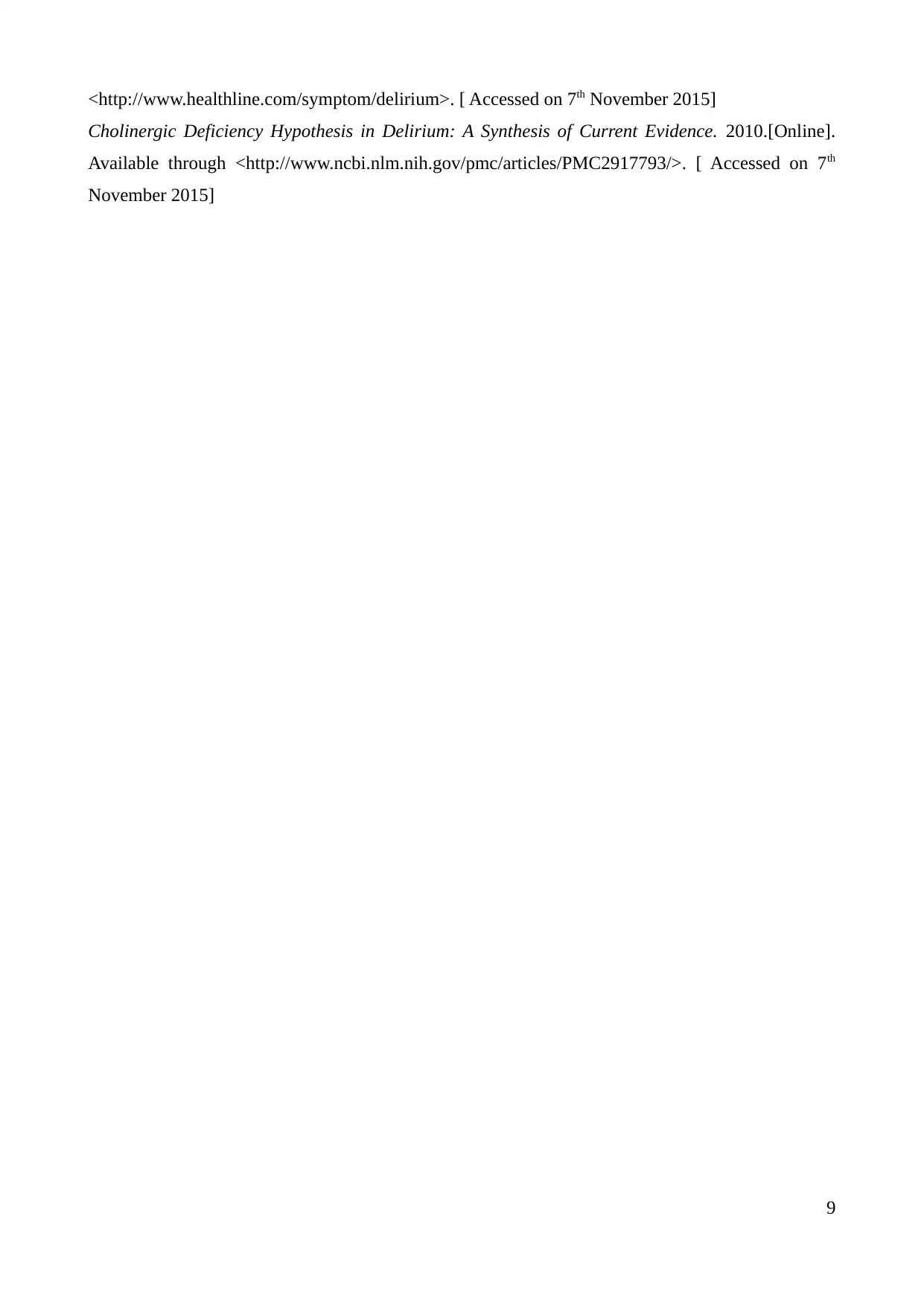
<http://www.healthline.com/symptom/delirium>. [ Accessed on 7th November 2015]
Cholinergic Deficiency Hypothesis in Delirium: A Synthesis of Current Evidence. 2010.[Online].
Available through <http://www.ncbi.nlm.nih.gov/pmc/articles/PMC2917793/>. [ Accessed on 7th
November 2015]
9
Cholinergic Deficiency Hypothesis in Delirium: A Synthesis of Current Evidence. 2010.[Online].
Available through <http://www.ncbi.nlm.nih.gov/pmc/articles/PMC2917793/>. [ Accessed on 7th
November 2015]
9
1 out of 9
Related Documents
Your All-in-One AI-Powered Toolkit for Academic Success.
+13062052269
info@desklib.com
Available 24*7 on WhatsApp / Email
![[object Object]](/_next/static/media/star-bottom.7253800d.svg)
Unlock your academic potential
© 2024 | Zucol Services PVT LTD | All rights reserved.





